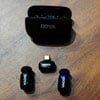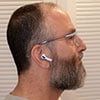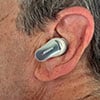We may earn commissions when you buy from links on our site. Why you can trust us.
Elehear Beyond Review: A Solid Value for Bluetooth OTC Hearing Aids
Getting quality audio for both conversation and wireless music listening from the same set of OTC hearing aids means compromise. Good conversation amplification means you’ll need perforated or slotted “open” ear tips that enable an equal mix of ambient and amplified sound to produce a natural-sounding conversation experience, but less than adequate (to put it mildly) music listening audio quality.
More solid “closed” canal-sealing ear tips isolate and improve hands-free phone calls and music listening, but result in less amplified, less natural-sounding conversation, and your own voice sounds more muted and detached during conversation.
Elehear’s Beyond over-the-ear receiver-in-canal (RIC) OTC hearing aids present a relatively affordable compromise between the good conversation and good Bluetooth music poles. You’ll get excellent, natural-sounding ambient amplified conversation and surprisingly full, loud wireless conversation and music with the included “open” ear domes. However, you’ll lose any music definition once you find yourself in an even semi-noisy environment such as a crowded city street, conversation-filled rooms, or loudly humming mass transit, regardless of whether you choose “open” or “closed” ear domes.
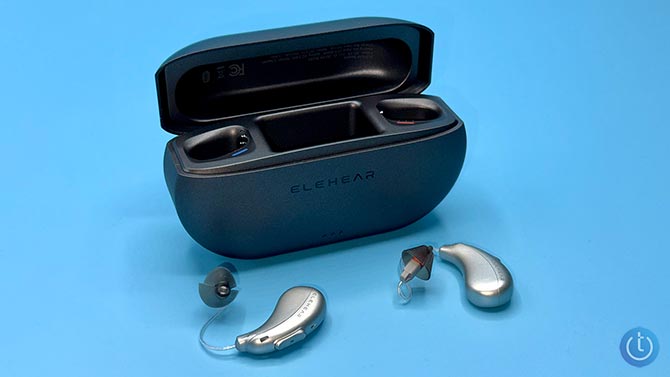
| + Pros | – Cons | ||
|
|
||
|
|||
Setup
Elehear Beyond are standard over-the-ear hearing aids with a teardrop battery/control module that sits behind the ear with a slim cable that fits over your ear and connects to an ear tip/ear dome that sits just inside your ear’s canal – hence this style of hearing aid’s “rest in canal,” or RIC, moniker.
Setting up the Beyond is stupid simple. Strip the plastic off the hearing pieces’ battery contacts to fully charge them in the case; a full charge takes just 2.5 hours, far shorter than the usual 4-hour charging time for a lot of OTC hearing aids. Download the Elehear app. Choose the Beyond on the main splash screen. Open the case with the buds inside and open your smartphone’s Bluetooth settings to pair the Beyond. Easy peasy.
Each time you freshly insert the Beyond after charging, ear pieces need a few seconds to re-pair with the app and your phone, and app controls are only available when the Bluetooth connection is established.
The Elehear include a selection of different-sized ear tips with the Beyond including small, medium, and large (SML) perforated “open” ear domes, SML solid “closed” ear domes, and a pair of cone-like “tulip” tips.

Also included is a pack of eight wax cap tip replacements, a tip cleaning brush/pick tool, and a “multi-function tool pen,” which lets you measure your ear length to determine if the default Beyond RIC connecting cable is the right length. Shorter or longer cables, if necessary, can be ordered from the company.
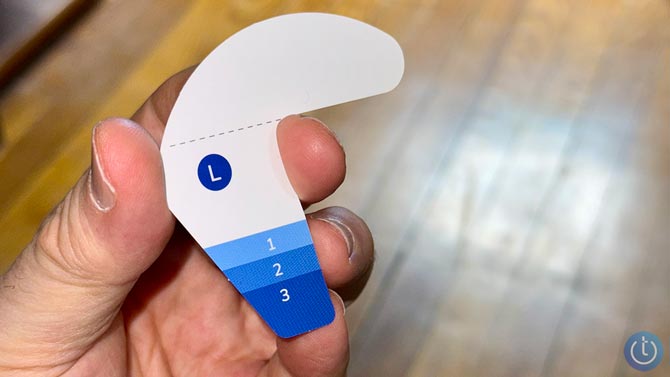
Battery life
Longer battery life per charge is the one big advantage of the Beyond versus bud-style Bluetooth-enabled OTC hearing aids, such as the HP Hearing Pro ($499) and the Apple AirPods Pro 2 ($249). With Bluetooth on and a mix of hearing assistance, hands-free calls, and music listening, I got 12-13 hours of battery life from the Beyond – a bit shy of true “all-day” wear usage. However, just 15 minutes of charging – while you shower, nap, take a walk, whatever – supplies 6 hours of additional juice to complete the day.
Read more: AirPods Pro 2 as Hearing Aids Review: Revolutionary, but Flawed
When I disconnected Beyond’s Bluetooth in my phone’s settings to use the Beyond merely as hearing aids, I got the rated “all-day” 20 hours of battery life on a single charge. It’s simple to switch the Beyond’s Bluetooth connection on or off in your phone’s Bluetooth settings to get the longest full-function battery life. You’ll just have to wait for the Bluetooth connection to re-establish itself for music and calls or to use the app.
As noted, the Beyond hearing aids take 2.5 hours to charge fully, and the charging case supplies a generous four full additional battery charges. By comparison, the similarly bulky case for the nearly twice as pricey Sennheiser All-Day Clear ($799) isn’t equipped with a battery for recharging at all.
Read more: Review: Sennheiser All-Day Clear - High-Quality Sound with a Catch
The Beyond charging case and each hearing piece have three battery charging level white LEDs, which means you’ll have to flip open the case to gauge the charging level of each earpiece.
Comfort and appearance
As noted, the Beyond are standard over-the-ear RIC hearing aids, which means they’ll be fairly invisible as you face someone head-on or even three-quarters, such as in a group conversation. However, the behind-the-ear modules are clearly visible to anyone behind you if you have short hair, like mine.
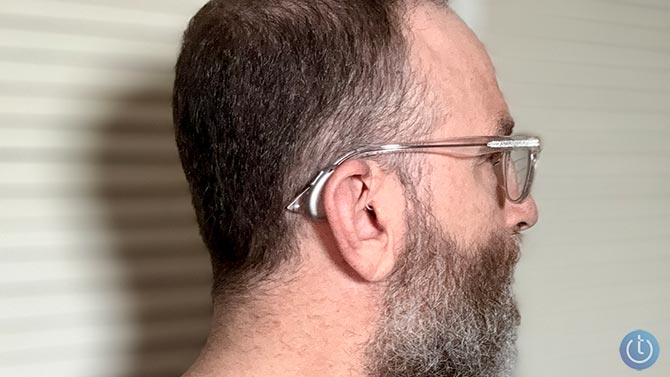
At 4.8 grams (0.17 oz), each hearing piece feels heavier than other RIC hearing aids I’ve tested. As a result, after several hours of wear, the earpiece cords felt as if they were cutting into where my ear meets my head, exacerbated by my glasses’ temples. I often had to lift my glasses’ temples to rest above my ears to relieve the pressure. I didn’t get this ear cutting discomfort from any other RIC hearing aids I’ve tried.
Since they feel heavier, Beyond seem to rattle or even clank against my glasses’ temples when I move my head, such as while jogging/running or just emphatically shaking my head “no.” And you’ll hear the earpiece modules rub against pillows and cushions you rest your head on.
By default, the Beyond come with the cone-shaped, one-size-fits-all “tulip” tips attached. They fit fine, but to me, they tickled my ear a bit. The round “open” and “closed” tips felt more natural and all-day comfortable.
Beyond’s other big drawback is the bulky carrying case, which measures a not-exactly-pocketable 4.09 x 2.34 x 1.33 inches and weighs a relatively hefty 4.23 ounces.
Bud and app controls
Each of Beyond’s behind-the-ear modules is equipped with a handy volume up-down/power on-off toggle; the volume toggle conveniently controls the loudness level of each individual hearing piece in case your hearing loss varies in each ear. With no other control buttons or touch controls, however, you’ll need to haul out your phone to answer/end hands-free phone calls or control Bluetooth music playback.
Elehear’s smartphone app includes a surprising plethora of audio shaping options and control settings. To shape their sound for your particular hearing issues, there are 19 levels of volume for left/right, separately or synced; “Brighter” or “Deeper” sliders from +/- 14 for left/right ear pieces separately or synced; automatic speech enhancement that, toggled off, lets you set Noise Control in nine levels including Off, Low, Mid, or High; and, Speech Focus, directional amplification for either 90 degrees in front of you or surrounding 360 degrees, which mainly adds amplified sounds around and behind you without diminishing the volume ahead of you.
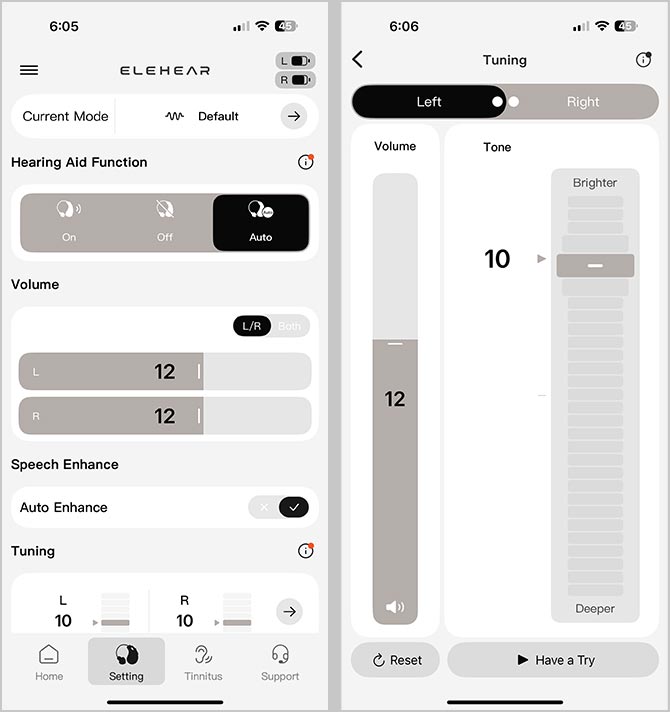
You also get 12 separate Tinnitus settings in the app – soundscapes including weather, nature, and transport noises, as well as white, pink, brown, and blue noises. I’ve had constant and severe tinnitus for decades (essentially pretty loud pink noise, which sounds like never-ending steam escaping), and these kinds of masking or distracting soundscape solutions have never worked for me, but your experience may differ. These soundscapes would work most effectively to assist sleep, but I don’t recommend wearing the Beyond to bed – lying on the side of your head will uncomfortably and painfully smush the hearing pieces on and into your ear and head.
Sound quality
Once you get the Brighter/Deeper balance right, and considering the Beyond are not self-fitting so don’t automatically adjust to your specific hearing loss issues, amplified conversation and TV sound is above average for pure amplification hearing aids, as long as you stick to the “tulip” or “open” ear dome tips.
“Open” ear tips keep the mix of ambient and amplified sound more natural. In relatively quiet environments such as your home or office, Bluetooth music and hands-free phone conversations sound slightly fuller with more volume than other Bluetooth RIC hearing aids I’ve tried. Helping to improve music playback and hands-free call quality while wearing “open” ear domes is an automatic muting of the Beyond microphones to reduce the interference of amplified ambient noise.
But make no mistake, all Bluetooth-enabled RIC OTC hearing aids suck when it comes to music playback, even the Beyond, especially in noisier environments, outdoors, or wind where most volume, fidelity subtleties, and higher frequencies are masked or simply washed away.
Wearing the “closed” domes will add more ear canal sealing to get a bit more isolated Bluetooth music and conversation listening at lower volume levels. However, this solution is vastly inferior to standard Bluetooth in-ear buds or headphones. Plus, ambient conversation sounds are sharpened and sound a little less natural. My own voice sounded only a bit more distant, rather than nearly muted, although not as much as the more music-oriented HP Hearing Pro or Apple AirPods Pro 2.
All in all, I prefer the Beyond’s “open” buds for all-around use, especially since I use them primarily for everyday conversation and TV listening rather than wireless music listening or hands-free calls. When you want to listen to music, you’ll want to swap the Beyond’s out for “real” Bluetooth buds. Technically, you could wear headphones over the Beyond, but, again, the earpieces would get potentially painfully squashed against your head and ears.
As with all non-self-fitting OTC hearing aids, you get several presets to compensate for specific ambient environments. But, as usual, I could barely discern a difference between the “General,” “Restaurant,” and “TV” presets. All produced a flatter, wider sound field than the default, which didn’t really enhance any of these ambient situations. The one preset exception was “Music,” which presented a noticeably wider soundstage and slightly more discernible frequency separation. For everyday use, Beyond’s “Default” setting sounded more focused and directional in front of me than any of the presets.
The bottom line
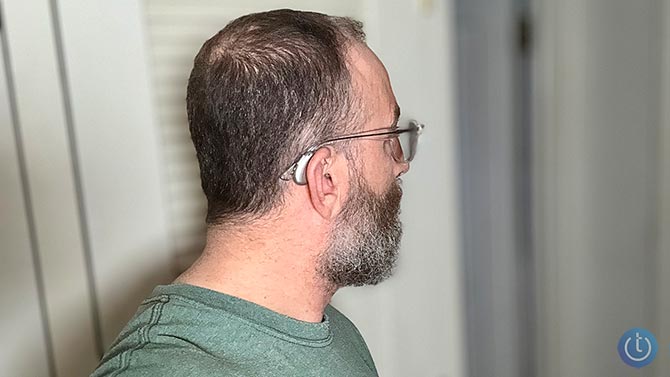
The Elehear Beyond are not self-fitting OTC hearing aids – there’s no app hearing test that tunes the Beyond to your specific hearing loss. Instead of personalized, tailored hearing improvement, the Elehear simply amplify everything, even with EQ and other audio customization options in the app. As such, the Beyond’s $399 (often discounted) price tag seems like a bargain compared to higher-priced self-fitting Bluetooth-enabled RIC hearing aids such as the Sennheiser All-Day Clear (now $799.95, but can be custom-tuned by an audiologist), the Bose-Lexie B2 Plus ($999), and the new non-self-fitting Audien Ion Pro ($689).
For what they do – excellent but non-customized hearing amplification, solid hands-free call quality, above average RIC Bluetooth music delivery, and reasonable battery life – the Elehear Beyond represent a great value compared to other current Bluetooth-enabled RIC non-self-fitting hearing aids. You’ll just have to either swap them out for “real” Bluetooth buds (or wear a pair of full-cup headphones over them) for acceptable music listening.
You can buy the Elehear Beyond in silver or “champagne” gold on Elehear.com for $399, and you’ll get a 45-day risk-free trial – you don’t even pay for return shipping.
Image credit: Stewart Wolpin/Techlicious, Elehear]


